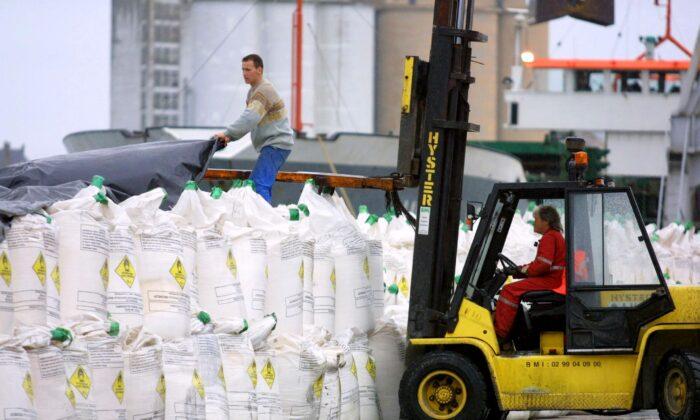Commercial freight carrier Union Pacific Corp. reported that a leak in a sealed hopper railcar hauling 60,000 pounds of ammonium nitrate most likely caused the chemical to disappear during transit in early April.
A Union Pacific spokesperson told The Epoch Times that the company’s four-month investigation wrapped up on Aug. 21 and that the company “fully cooperated with authorities.”
The spokesperson said that “all the available evidence suggests this was a leak that occurred from transportation from origin to destination.”
“Such a leak is unlikely to pose any risk to public health or the environment,” the spokesperson said. “Union Pacific has no reason to believe any criminal or otherwise malicious activity took place during transport.”
On May 10, explosives manufacturer Dyno Nobel filed an incident report with the U.S. Environmental Protection Agency’s (EPA) National Response Center after finding the entire rail car empty of its contents in Saltdale, California.
The sealed Union Pacific railcar left the company’s Cheyenne, Wyoming, facility on April 12, traveling 800 miles to its final destination.
Leak Suspected
Dyno Nobel suspected that a leak through a bottom gate on the multi-compartment hopper car might have developed during transit.“The initial assessment is that a leak through the bottom gate on the railcar may have developed in transit—releasing pellets totaling approximately 60,000 pounds onto the tracks over the two-week trip,” a company spokesperson wrote in May.
According to New York-based Nortech Labs, ammonium nitrate isn’t harmful under normal handling conditions.
However, inhaling high concentrations of ammonium nitrate dust can cause respiratory tract irritation and irritate the eyes, nose, and skin.”
While ammonium nitrate’s rating is nonflammable, the company noted that it’s a “strong oxidizing agent” that can make combustible materials catch fire.
“Only under extreme conditions of heat and pressure in a confined space will ammonium nitrate explode,” it stated. “Should such an incident occur, there may be a visible cloud of ammonia, carbon dioxide, and nitrogen oxides.”
In June 2015, the EPA, Occupational Safety and Health Administration, and Bureau of Alcohol, Tobacco, Firearms, and Explosives issued an advisory regarding the potential for explosions involving ammonium nitrate.
While incidents involving ammonium nitrate are rare, “they can have severe consequences.,” the advisory stated.
One incident occurred on April 17, 2013, when a fire at an ammonium nitrate storage and distribution facility in West, Texas, caused an explosion that killed 15 people, injured more than 250, and damaged several buildings.
Officials at the EPA and Dyno Nobel didn’t respond by press time to a request by The Epoch Times for comment.
Dyno Nobel is a global commercial explosives manufacturer, producing more than 54 million pounds of packaged explosives and about 1.2 million tons of ammonium nitrate capacity.
The company operates in 32 facilities with more than 3,770 employees.
The U.S. Department of Transportation’s Federal Railroad Administration told The Epoch Times the EPA hasn’t responded to the incident “due to ammonium nitrate [common fertilizer] not being listed as a hazardous substance under federal law.
“EPA’s role generally is to get involved when incidents raise hazardous substance issues. That said, we are prepared to provide assistance should it be requested.”







